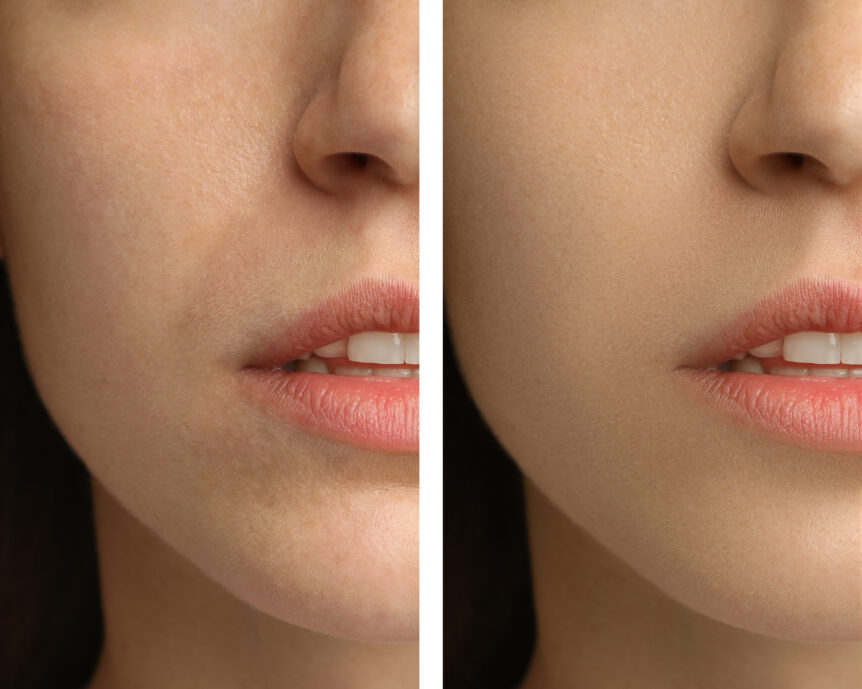The Why of Dry Skin and How to Deal with It
Itchy. Flaky. Red. Rough. Raw. Stinging. Chapped. Cracked. Scratchy. Dry skin can be all of these and more. This very common condition is also uncomfortable, unflattering, and annoying, yet most of us experience it at various times in our lives. Dry skin can happen anywhere on the body but is most frequent and noticeable on our faces and hands. Feet are prone to dryness as well.
Fortunately, dry skin is usually mild and manageable with a combination of judicious attention and TLC. Here’s how.
Multiple Factors Can Trigger Dry Skin
Dryness occurs when the top layer of your skin lacks the moisture, healthy fats, and natural oils that protect it from harm. The medical term for this weakened skin barrier is xeroderma, and it often happens naturally with changing seasons, harsh products, vitamin deficiencies, sun damage, and more.
Improvement of your skin’s health starts with understanding what’s causing dryness in the first place. Among frequent culprits:
- Climate. When the calendar says winter, skin gets dry. Weather turns cold, temperatures drop, vitamin D from natural sunlight is lacking, and inside environments are heated with forced air, all of which suck moisture from the skin. Those living in arid locations deal with skin-drying conditions like low humidity year-round.
- Strong soaps and fragrances. Many soaps, shampoos, body washes, cleansers, deodorants, detergents, fabric softeners, and dryer sheets contain ingredients that are formulated to remove oil. In the process, they extract hydration. Elements that add fragrance to lotions and creams can do the same.
- Zealous handwashing, overbathing, and hard water. The emphasis on handwashing and sanitizing associated with Covid-19 is a plus for health overall. And long, hot showers or steaming, bubble-filled soaks just plain feel good. But these practices strip water and natural oils. That’s especially true if you live in an area with a high concentration of minerals in your tap water. The resulting hard water leaves a coating on skin that prevents absorption of moisturizing elements.
- Occupational or recreational exposure to chemicals and sun. Some professions, like hairstyling, health/homecare, medicine, food service, maintenance, construction, and others require the use of chemicals, frequent handwashing, and other types of skin exposure. Water and winter sports such as swimming, surfing, sailing, skiing, and snowboarding stress skin through overexposure to chemicals and/or sun. UV rays are always a concern since sun damage can cause cancer and other problems that are far more serious than dry skin.
- Health and food habits. Certain foods, including coffee, sodas, and other items containing caffeine, can lead to skin dryness when consumed in large amounts. Smoking and excessive alcohol are also damaging to skin.
- Genetics. Dry skin runs in some families, often as a result of mutations involved in forming and hydrating the skin barrier. Being aware of those realities allows use of countermeasures to compensate for what Mother Nature fails to provide.
- Aging. Skin naturally gets drier after the age of 40. Hormone and other changes mean you produce less of the hydrating agents your skin needs to stay refreshed.
Keep in mind that dryness often results from a combination of factors. Looking at your overall situation and daily habits is the basis for figuring out what’s contributing to your skin situation and determining next steps.

Try These Remedies to Freshen and Hydrate Skin
Many are simple changes, but they definitely produce results.
- Limit length and frequency of showers and baths. Hot water and overwashing dry your skin. Skin care experts recommend limiting showers to 10 minutes—5 minutes is better—and avoiding extended bathing altogether, especially in winter. Unless you’re exercising heavily or involved in a profession that calls for frequent cleansing, showering every other day is enough.
- Apply moisturizer immediately after showering or sanitizing hands. Closing the door while showering keeps moisture in the bathroom for your skin to absorb. Water should be warm, not hot; cleansing with a gentle, fragrance-free product is better than rough bar soap. As soon as you pat or blot your skin with a soft towel (don’t rub), trap dampness by generously using moisturizer, also fragrance-free. Since you’re spritzing hand sanitizers frequently and such products contain alcohol, keep moisturizing lotion handy and apply as soon as possible after each sanitizer use.
- Read ingredient labels and opt for ointments and creams. Avoid anything with alcohol or fragrance since such elements are often irritating to skin. Creams and ointments are preferable because they cling to skin more effectively than lotions. Look for products that contain moisture-friendly hyaluronic acid and ceramides; jojoba oil, glycerin, lactic acid, lanolin, mineral oil, and shea butter can also benefit dry skin, although oils and shea butter may trigger breakouts in some people by clogging pores and trapping dirt and debris. Also be careful with exfoliation. Exfoliants are potent and strip oils and moisture, making dry skin even worse.
- Protect your hands. That means wearing gloves when out in cold weather, as well as protecting hands while doing dishes, cleaning, washing the car, working with chemicals, or coming in contact with irritants of any kind.
- Install a humidifier. Placing a device in the room where you sleep or elsewhere in your home counteracts dry winter heat and low-humidity environments. Setting the machine between 30% and 50% humidity is perfect for moisturizing skin. If your furnace has a built-in humidifier, make sure it’s turned on and working.
- Wear non-irritating fabrics. Clothes can stress skin, especially wool and rough cottons that rub and scratch. Polyester, acrylics, rayon, and nylon often irritate when in direct contact with skin. Wearing silk, soft cotton, or other natural fabrics next to skin soothes and protects. Laundry products can also irritate, so choose detergents and softeners that are hypoallergenic.
- Hydrate from the inside. That means consuming enough water and fluids to keep skin moisturized while eating foods that are high in antioxidants and omega-3 fatty acids. Egg yolks, oat flakes, tomatoes, spinach, salmon, dairy products, bananas, walnuts, and seeds help support supple skin. Do not smoke or drink to excess.
- Sunscreen every day. Rain or shine, year-round, in every climate, sunscreen protects your skin and contributes to good health.
Remember that techniques for hydrating are not a once-and-done endeavor. You want to adjust methods and products to match the time of year, surroundings, activities, health, and age that are constantly impacting the wellbeing of your skin.

When to See the Dermatologist
Depending on what’s causing your dry skin and the remedies you use to treat it, you should start seeing results in a couple weeks. A possible exception is dryness linked to use of acne medications and retinol. While the salicylic acid in acne treatments is effective at unplugging blocked pores to shrink blackheads, whiteheads, and pimples, it’s a powerful substance that may irritate, especially upon initial use. The same is true of retinol, which exfoliates skin and reduces the appearance of lines and wrinkles. In most cases, cutting down on frequency of use or switching to a lower concentration counters adverse effects, letting you enjoy the benefits without drying your skin.
Warning signs that something more serious is going on should be taken seriously. If you experience ongoing bleeding, severe inflammation, intense itching, yellow crusting, or dryness that impairs your ability to work or sleep, it’s time to see your primary care physician or a dermatologist. Extreme, extended dry skin symptoms can signal an unrelated and potentially serious health condition such as bacterial or viral infection, diabetes, hypothyroidism, kidney failure, nutrition deficiency, autoimmune disorder, or other illnesses. Your healthcare provider can determine the cause and prescribe treatment that works.
He or she will also provide helpful tips for maintaining good skin health and handling dryness. With a little care and attention, you can have moist, attractive skin that makes you look and feel your best.

